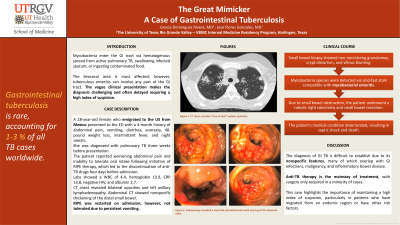Monday Poster Session
Category: Small Intestine
P2705 - The Great Mimicker: A Case of Gastrointestinal Tuberculosis
Monday, October 23, 2023
10:30 AM - 4:15 PM PT
Location: Exhibit Hall

Has Audio

Grecia Dominguez Rivera, MD
University of Texas Rio Grande Valley
Harlingen, Texas
Presenting Author(s)
Grecia Dominguez Rivera, MD, Jose R. Flores Gonzalez, MD
University of Texas Rio Grande Valley, Harlingen, TX
Introduction: Gastrointestinal (GI) tuberculosis (TB) is rare, accounting for 1-3% of all TB cases worldwide. Mycobacteria enter the GI tract via hematogenous spread from active pulmonary TB, swallowing infected sputum, or ingesting contaminated food. The ileocecal area is most affected; however, tuberculous enteritis can involve any part of the GI tract. The vague clinical presentation makes the diagnosis challenging and often delayed requiring a high index of suspicion.
Case Description/Methods: A 28-year-old female who emigrated to the US from Mexico presented to the ED with a 4-month history of abdominal pain, vomiting, diarrhea, anorexia, 40-pound weight loss, intermittent fever, night sweats, and dry cough. Medical history included untreated rheumatoid arthritis, SLE, and pulmonary tuberculosis, diagnosed 3 weeks before presentation.
The patient reported worsening abdominal pain and inability to tolerate oral intake following initiation of RIPE therapy, which led to discontinuation of anti-TB drugs 4 days before admission. Physical exam revealed diffuse abdominal tenderness. Labs showed a WBC of 4.4, hemoglobin 10.9, CRP 13.8, negative HIV, and albumin 2.7. CT chest revealed bilateral opacities and left axillary lymphadenopathy. Abdominal CT showed nonspecific thickening of the distal small bowel. RIPE was restarted on admission; however, not tolerated due to persistent vomiting.
Colonoscopy revealed a mass-like ulcerated lesion with scarring of the ileocecal valve. Small bowel biopsy showed non-necrotizing granulomas, crypt distortion, and villous blunting. Mycobacteria species were detected via acid-fast stain compatible with mycobacterial enteritis. Due to small bowel obstruction, the patient underwent a robotic right colectomy and small bowel resection. Pathology showed granulomatous enterocolitis with 24 lymph nodes with varying degrees of granulomatous inflammation. The patient’s medical condition deteriorated, resulting in septic shock and death.
Discussion: The diagnosis of GI TB is difficult to establish due to its nonspecific features, many of which overlap with GI infections, malignancy, and inflammatory bowel disease. Anti-TB therapy is the mainstay of treatment, with surgery only required in a minority of cases. In our patient, delayed recognition and treatment led to disease progression, complications, and death. This case highlights the importance of maintaining a high index of suspicion, particularly in patients who have migrated from an endemic region or have other risk factors.
Disclosures:
Grecia Dominguez Rivera, MD, Jose R. Flores Gonzalez, MD. P2705 - The Great Mimicker: A Case of Gastrointestinal Tuberculosis, ACG 2023 Annual Scientific Meeting Abstracts. Vancouver, BC, Canada: American College of Gastroenterology.
University of Texas Rio Grande Valley, Harlingen, TX
Introduction: Gastrointestinal (GI) tuberculosis (TB) is rare, accounting for 1-3% of all TB cases worldwide. Mycobacteria enter the GI tract via hematogenous spread from active pulmonary TB, swallowing infected sputum, or ingesting contaminated food. The ileocecal area is most affected; however, tuberculous enteritis can involve any part of the GI tract. The vague clinical presentation makes the diagnosis challenging and often delayed requiring a high index of suspicion.
Case Description/Methods: A 28-year-old female who emigrated to the US from Mexico presented to the ED with a 4-month history of abdominal pain, vomiting, diarrhea, anorexia, 40-pound weight loss, intermittent fever, night sweats, and dry cough. Medical history included untreated rheumatoid arthritis, SLE, and pulmonary tuberculosis, diagnosed 3 weeks before presentation.
The patient reported worsening abdominal pain and inability to tolerate oral intake following initiation of RIPE therapy, which led to discontinuation of anti-TB drugs 4 days before admission. Physical exam revealed diffuse abdominal tenderness. Labs showed a WBC of 4.4, hemoglobin 10.9, CRP 13.8, negative HIV, and albumin 2.7. CT chest revealed bilateral opacities and left axillary lymphadenopathy. Abdominal CT showed nonspecific thickening of the distal small bowel. RIPE was restarted on admission; however, not tolerated due to persistent vomiting.
Colonoscopy revealed a mass-like ulcerated lesion with scarring of the ileocecal valve. Small bowel biopsy showed non-necrotizing granulomas, crypt distortion, and villous blunting. Mycobacteria species were detected via acid-fast stain compatible with mycobacterial enteritis. Due to small bowel obstruction, the patient underwent a robotic right colectomy and small bowel resection. Pathology showed granulomatous enterocolitis with 24 lymph nodes with varying degrees of granulomatous inflammation. The patient’s medical condition deteriorated, resulting in septic shock and death.
Discussion: The diagnosis of GI TB is difficult to establish due to its nonspecific features, many of which overlap with GI infections, malignancy, and inflammatory bowel disease. Anti-TB therapy is the mainstay of treatment, with surgery only required in a minority of cases. In our patient, delayed recognition and treatment led to disease progression, complications, and death. This case highlights the importance of maintaining a high index of suspicion, particularly in patients who have migrated from an endemic region or have other risk factors.
Disclosures:
Grecia Dominguez Rivera indicated no relevant financial relationships.
Jose Flores Gonzalez indicated no relevant financial relationships.
Grecia Dominguez Rivera, MD, Jose R. Flores Gonzalez, MD. P2705 - The Great Mimicker: A Case of Gastrointestinal Tuberculosis, ACG 2023 Annual Scientific Meeting Abstracts. Vancouver, BC, Canada: American College of Gastroenterology.

